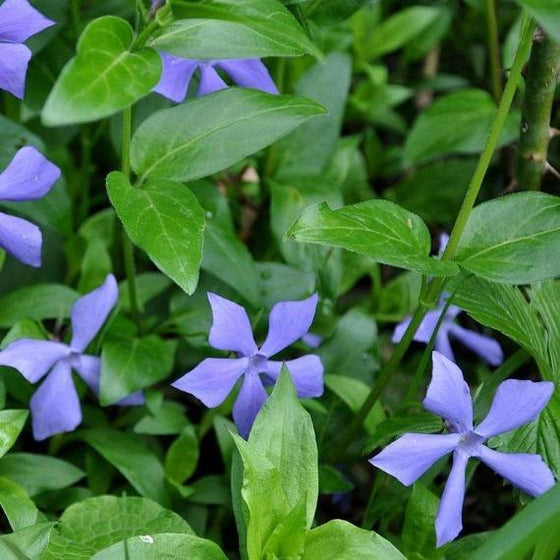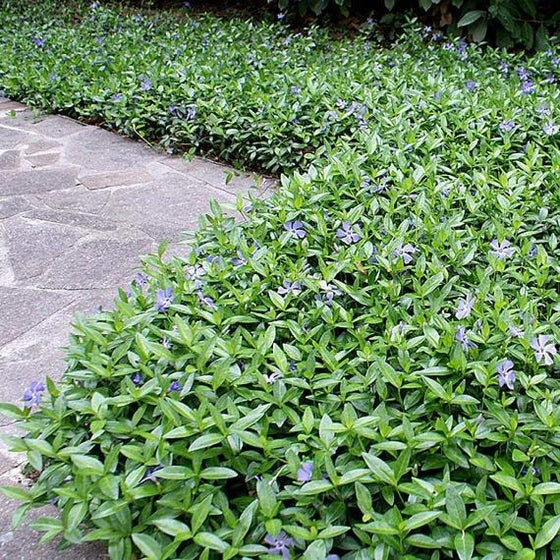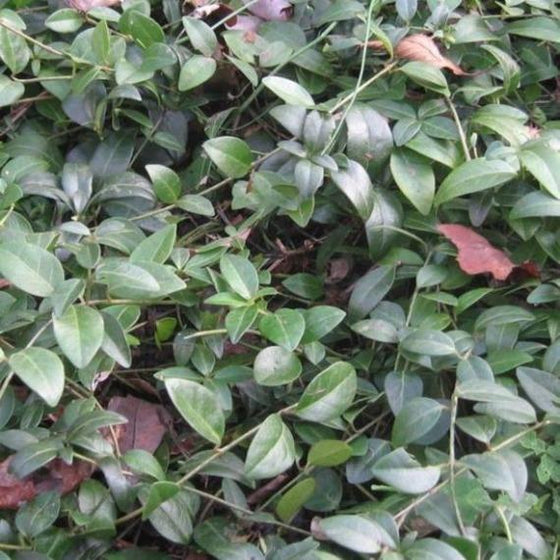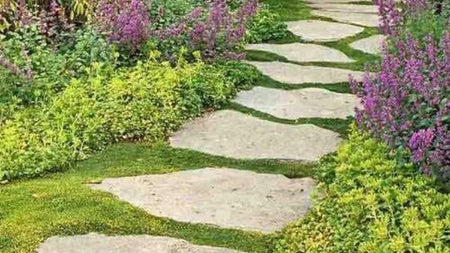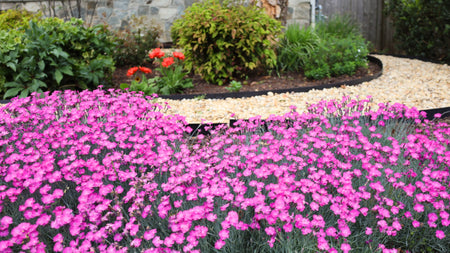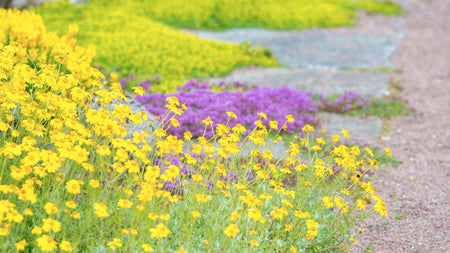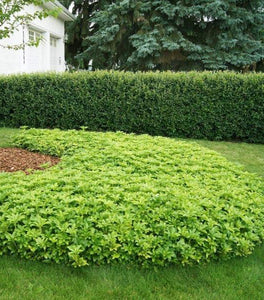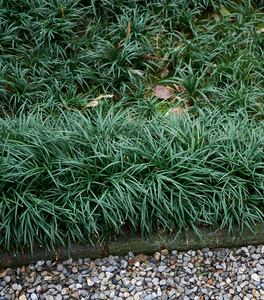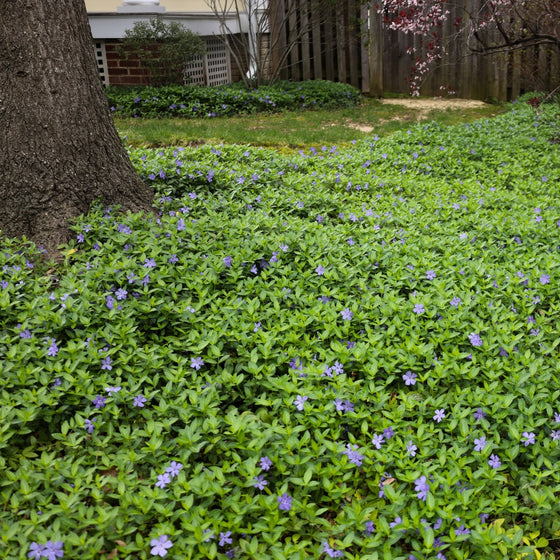
Images Depict Mature Plants
A Classic Evergreen Groundcover with Year-Round Charm
Evergreen Foliage and Cheerful Blue Blooms
Vinca minor, commonly known as Common Periwinkle or Creeping Myrtle, is a beloved groundcover prized for its glossy green foliage and soft violet-blue spring flowers. Blooming from mid-spring through early summer, it brightens shady areas where few other plants thrive. Even after the blooms fade, its evergreen leaves maintain color and texture all year long.
Tough, Spreading, and Beautifully Versatile
Growing only 4–6 inches tall, Vinca minor spreads by trailing stems that root as they creep, forming a dense, weed-suppressing mat of foliage. It’s ideal for shaded slopes, beneath trees, or along walkways where traditional grass struggles. Its cascading habit also makes it an excellent choice for containers or raised beds.
Low-Maintenance and Drought-Tolerant Once Established
Once planted, Vinca minor requires very little upkeep. It tolerates a wide range of soils, resists deer and rabbits, and performs well even in dry, shaded areas after establishment. It’s a fantastic problem-solver for areas prone to erosion, thanks to its dense root network that helps stabilize soil naturally.
Perfect for Naturalistic and Formal Gardens Alike
This adaptable perennial suits woodland gardens, cottage landscapes, or even manicured beds. Its subtle blooms pair beautifully with hostas, ferns, and hellebores for layered color and contrast in the shade garden.
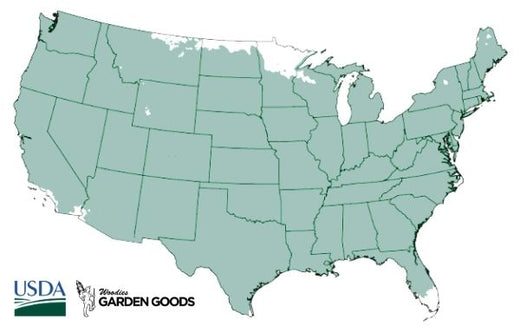
| Botanical Name | Vinca minor |
|---|---|
| Hardiness Zone: | 4-9 |
| Mature Height: | 4 to 6 Inches |
| Mature Width: | 18 Inches |
| Sunlight: | Partial to Full Shade |
| Water Requirements: | Low to Moderate once established |
| Soil | Moist, well-drained soils; adaptable |
| Bloom Time / Color | Spring / Violet-Blue |
| Resistance | Deer- and rabbit-resistant |
| Landscape Uses | Groundcover, erosion control, slopes, under trees, borders |
How to Care for Vinca minor
Before you buy a Vinca Minor Plants make sure to read about the recommended care instructions to keep this plant healthy and thriving.
How should I plant Vinca minor?
Choose a site with partial to full shade and moist, well-drained soil. Loosen the planting area and amend heavy clay with organic matter for improved drainage. Dig a hole twice as wide and as deep as the root ball, set the plant so the crown is level with the soil surface, and gently backfill. Firm the soil lightly and water thoroughly after planting to help settle roots. For mass plantings, space plants 8–12 inches apart depending on how quickly you want full coverage. Closer spacing fills in within one season, while wider spacing saves on plants and fills in over two. Add mulch around new plants to retain moisture, suppress weeds, and protect young roots as they establish.
How often should I water Vinca minor after planting?
Water deeply once or twice per week during the first growing season to encourage root establishment. Always allow the soil to partially dry between waterings to prevent root rot. Vinca prefers consistent moisture but not standing water, especially in shaded or compacted areas. Once established, it becomes remarkably drought-tolerant, often thriving on rainfall alone. During extended dry spells, a thorough watering every two weeks will keep foliage fresh and vibrant, especially in exposed or sloped areas.
When should I fertilize Vinca minor?
Fertilize once in early spring using a slow-release balanced fertilizer (such as 10-10-10) or a light layer of compost. This encourages new growth and enhances flowering. Avoid heavy feeding, as excessive nitrogen can promote leafiness at the expense of blooms. In subsequent years, an annual top-dressing of organic compost or leaf mulch in spring is sufficient. This maintains healthy soil structure and supports the plant’s natural spreading habit without over-stimulating growth.

When and how should I prune Vinca minor?
Prune or shear lightly after flowering to maintain shape and encourage thicker growth. This keeps the groundcover looking tidy and prevents it from encroaching onto walkways or flower beds. Use sharp shears to avoid tearing stems, which could invite disease. Every 3–4 years, rejuvenate overgrown or matted areas by cutting back one-third of the foliage and re-mulching. This refreshes the planting and promotes vigorous new shoots.

